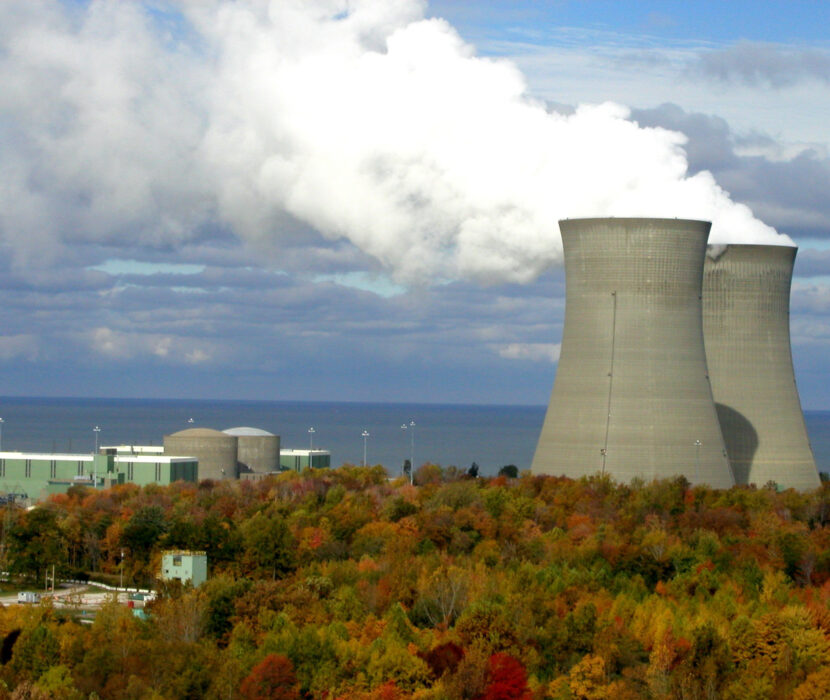
In an interview for the second season of the Brookings Institution’s Climate Sense podcast, EFI Foundation (EFIF) CEO Ernest J. Moniz spoke with host Samantha Gross about how both hydrogen and nuclear power can help decarbonize the U.S. electric grid.
The variability of other renewable sources naturally spurs conversation about hydrogen and nuclear energy—which can provide “firm” (i.e., reliable and constant) power to the U.S. grid. By contrast, wind and solar play important roles but are dependent on regional weather conditions.
Among sources of firm power, nuclear energy is the only one that does not release greenhouse gas emissions. Moniz emphasized that investing in nuclear power will ensure that the U.S. grid remains stable and secure, especially in regions that have installed other non-fossil-fuel power sources.
“We are going to need firm power, power that is dispatchable as a balance to variable power, as a way of avoiding not just hourly interruptions or short interruptions,” Moniz said. “If you look at, say, Texas (which is the home of the most wind [power] in the United States), Texas in a typical year will have 9-10 days in a row with no wind, depending on the season.” He noted that energy storage cannot fill that gap, so firm power is necessary.
Moniz also underscored the importance of nuclear power in light of projected electricity load growth in the United States. The use of increasingly powerful data centers, the electrification of U.S. industry, and the projected growth in domestic manufacturing are all anticipated to significantly boost electricity demand. Investing in nuclear power can help meet this growing demand and decarbonize the U.S. grid.
Several challenges exist for scaling up nuclear energy production—including project costs and financing. But these challenges are not insurmountable. Moniz spoke to the potential for a product-based model for development—under which planning and human capital are oriented in ways that reduce overall cost.
“In the manufacturing environment, you also have a stable, well-trained workforce. [Scaling nuclear energy is] much harder to do when you have a project mentality of one reactor here and one reactor there,” Moniz said. “It probably requires a transition from a project mentality to a product mentality, much the way Boeing or Airbus turn airplanes off of their production lines.”
Moniz noted that new nuclear installations could be built by adapting current infrastructure to expedite development, “You can easily site [them] in places that can take advantage of existing grid infrastructure and minimize the need for new infrastructure. You can imagine doing that through, for example, replacing current coal plants.”
Turning to hydrogen, Moniz outlined how hydrogen will be another critical component for decarbonizing various sectors of the U.S. economy, including transportation. He also highlighted how using nuclear power in the production of hydrogen could help scale clean hydrogen considerably.
Hydrogen has potential as a clean fuel for modes of transportation that have proven more challenging to electrify than smaller vehicles. “It could be a way of serving especially heavy transportation trucks. … [Hydrogen] could be a fuel for long-distance shipping, for example, Moniz said.
Heavy industry also holds promise for hydrogen adoption, as hydrogen could decarbonize processes such as steel production by replacing more carbon-intensive fuels.
Moniz emphasized that reducing the cost of hydrogen production is a necessary precursor to large-scale adoption across transit and industry—an effort that is being facilitated by the Department of Energy’s H2DI program, which is led by EFIF. H2DI is designed to be a high-impact hydrogen demand-side effort to leverage private investment effectively and efficiently to support the commercial deployment of clean hydrogen by bringing together diverse stakeholders to explore market and policy innovations.
“DOE has selected seven [hydrogen] hubs. We will work with them to leverage additional federal funding to design and then implement a program to leverage additional private capital on the demand side of the equation,” Moniz said.
In a related episode of the Climate Sense podcast, Moniz elaborated on the importance of finding means of transforming hydrogen into a more affordable, scalable energy source.
“You should be comparing this to the wholesale price of gasoline. Fundamentally, you’d like to get that hydrogen cost down … in which case, hydrogen could really take off and serve all of those end use sectors that we discussed earlier,” Moniz said.
– Adam Patterson, Communications Associate
– Adrienne Young, Senior Communications Lead
(Share this post with others.)




